Tom's Hardware Verdict
The 16-inch MacBook Pro has the keyboard Mac users have been waiting for, along with amazing speakers and long battery life. But it’s time to add more ports for pros.
Pros
- +
Magic keyboard is great
- +
Best audio I’ve ever heard from a laptop
- +
Long battery life
- +
Strong performance
Cons
- -
Pros need more ports and SD card slot
- -
32-bit apps and games need replacements or fixing
Why you can trust Tom's Hardware
This is the MacBook Pro people have been hoping for. The 16-inch MacBook Pro ($2,399 to start; $3,899 as tested) has brought back the scissor switch keyboard. That may be enough for some, but it also boasts the most impressive audio we’ve seen in a laptop, long battery life and powerful productivity performance. There is more that we’d like to see Apple address, like a lack of ports, but if macOS is what you want and power is what you need, this is the MacBook Pro that creatives have long been awaiting.
Design
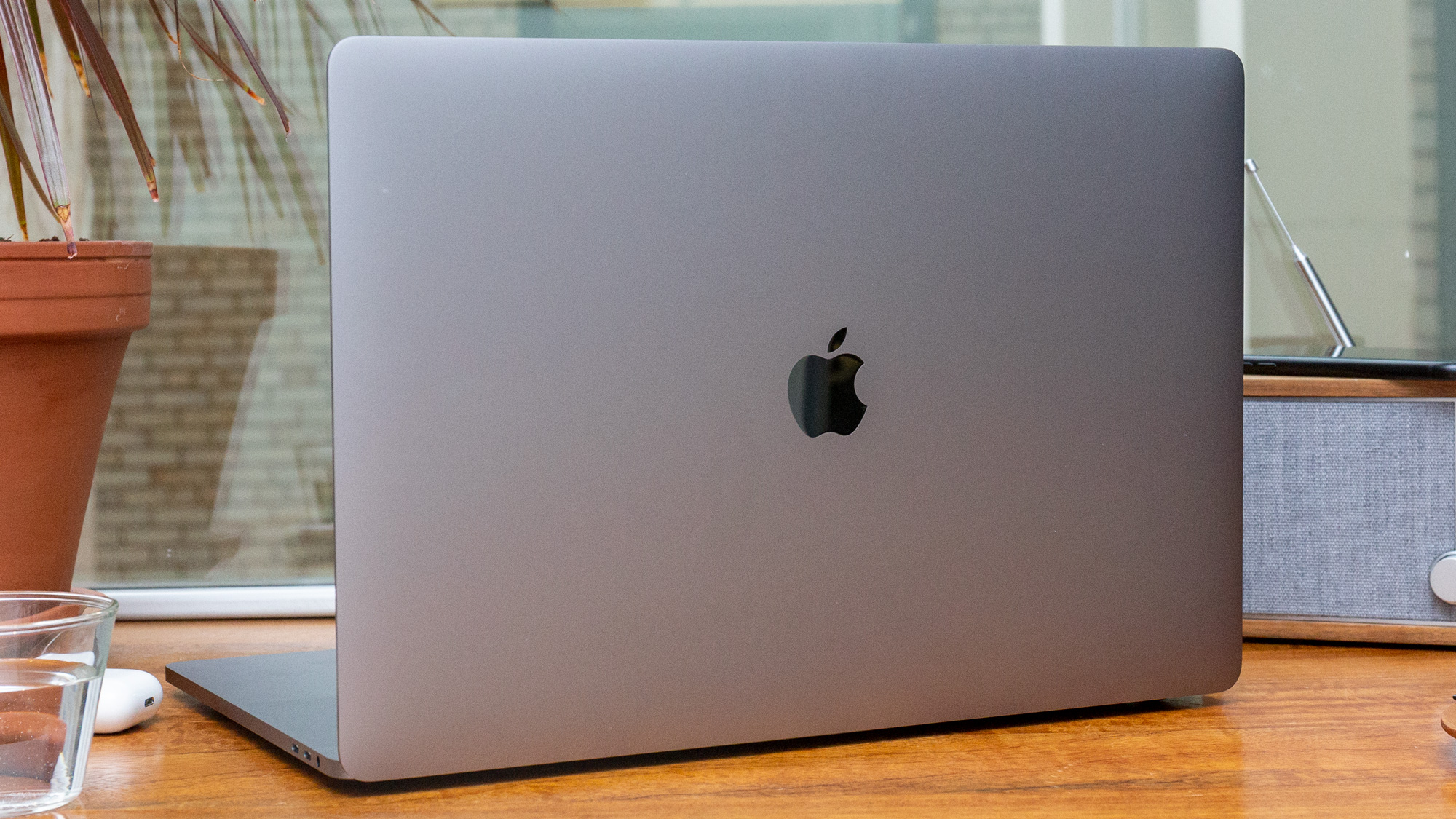


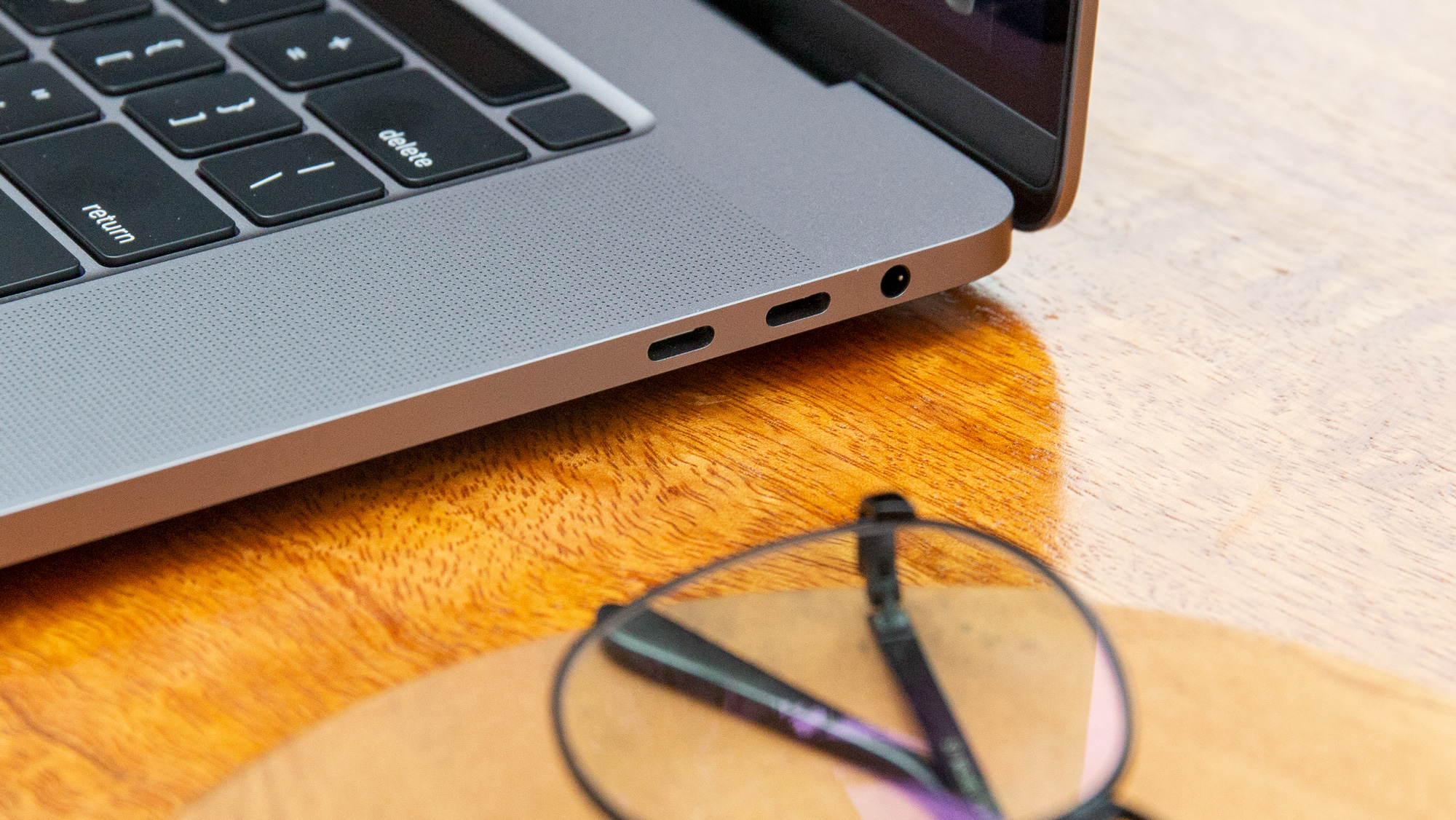



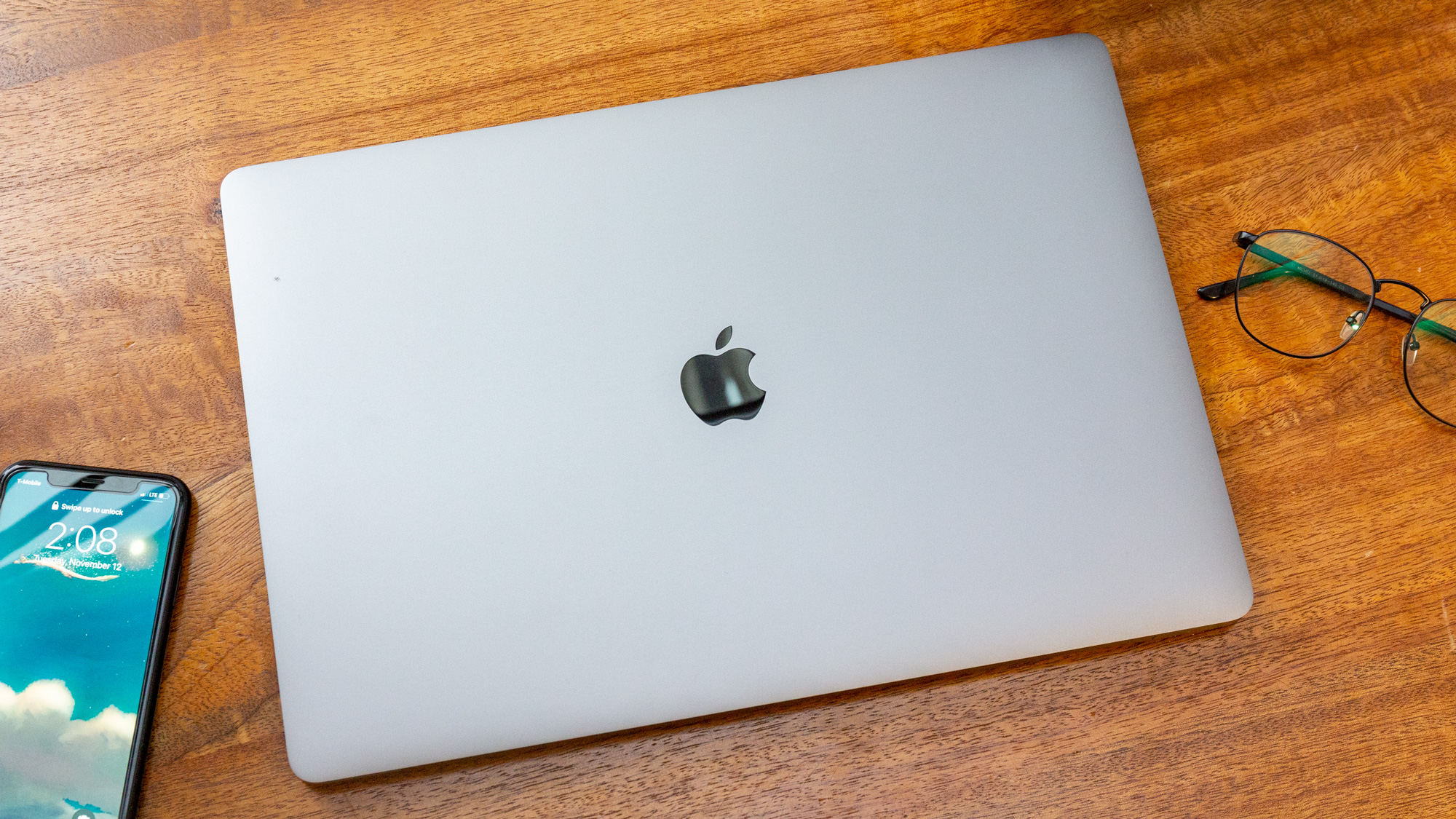
The MacBook Pro’s overall design hasn’t changed very much. It’s a silver, aluminum rectangle, but it’s bigger than the 15-inch model of yesteryear. Ours came in space gray, but Apple also sells it in silver. There’s a reflective Apple logo on the lid, but it’s otherwise spartan. The design is a few years old, but it’s still classy and understated, albeit it very minimalist. The changes are more evident when you lift the lid. The 16-inch, 3072 x 1920 display features True Tone technology, which is supposed to automatically adjust the screen based on your room's lighting to make colors seem more natural, and is surrounded by the thinnest bezels on a modern MacBook Pro.
The keyboard has a few slight aesthetic and functionality changes. (See the Keyboard, Touchpad and Touch Bar section below for the full details.) At first glance, you’ll notice that the escape key is back and that the power button with Touch ID has been separated from the Touch Bar. Additionally, Apple has adjusted the arrow keys to an upside down “T” layout, making all of the keys the same size and easier to distinguish from each other. Speaker grills flank both sides of the keyboard.
At 16-inches, the MacBook Pro is between the more popular 15 and 17-inch screen sizes. It weighs 4.3 pounds and measures 14.1 x 9.7 x 0.6 inches (358 x 246 x 16mm). The Dell XPS 15 measures 14.9 x 9.7 x 0.7 inches and weighs 4.5 pounds, while the Razer Blade Pro 17 is 6 pounds and 15.6 x 10.2 x 0.7 inches.
The ports are somewhat sparse on this laptop. There are four Thunderbolt 3 ports (two on each side of the machine), and a headphone jack on the right side. While that’s more Thunderbolt 3 ports than most laptops, which can be used for charging, video output and peripherals and storage with USB-C. But I do wish that with the extra space, Apple would have added a more common video out port, like HDMI. A full-size SD card slot would also be more than welcome. I think many pros would even put up with some extra thickness for it.
Specifications
| CPU | Intel Core i9-9980HK |
| Graphics | AMD Radeon Pro 5500M |
| Memory | 32GB DDR4 2666MHz |
| Storage | 2TB M.2 PCIe SSD |
| Display | 16-inch (3072 x 1920) True Tone |
| Networking | 802.11ac Wi-Fi, Bluetooth 5.0 |
| Ports | 4x Thunderbolt 3; 3.5mm Headphone jack; |
| Camera | 720p webcam |
| Battery | 100 Whr |
| Power Adapter | 96W |
| Operating System | macOS 10.15 Catalina |
| Dimensions (WxDxH) | 14.1 x 9.7 x 0.6 inches (358 x 246 x 16mm) |
| Weight | 4.3 pounds |
| Price (as configured) | $3,899.00 |
Productivity Performance
The 16-inch MacBook Pro we reviewed came packed with an Intel Core i9-9980HK, 32GB of DDR4 RAM at 2666MHz a 2TB PCIe M.2 SSD and an AMD Radeon Pro 5500M graphics card with 8GB of memory.
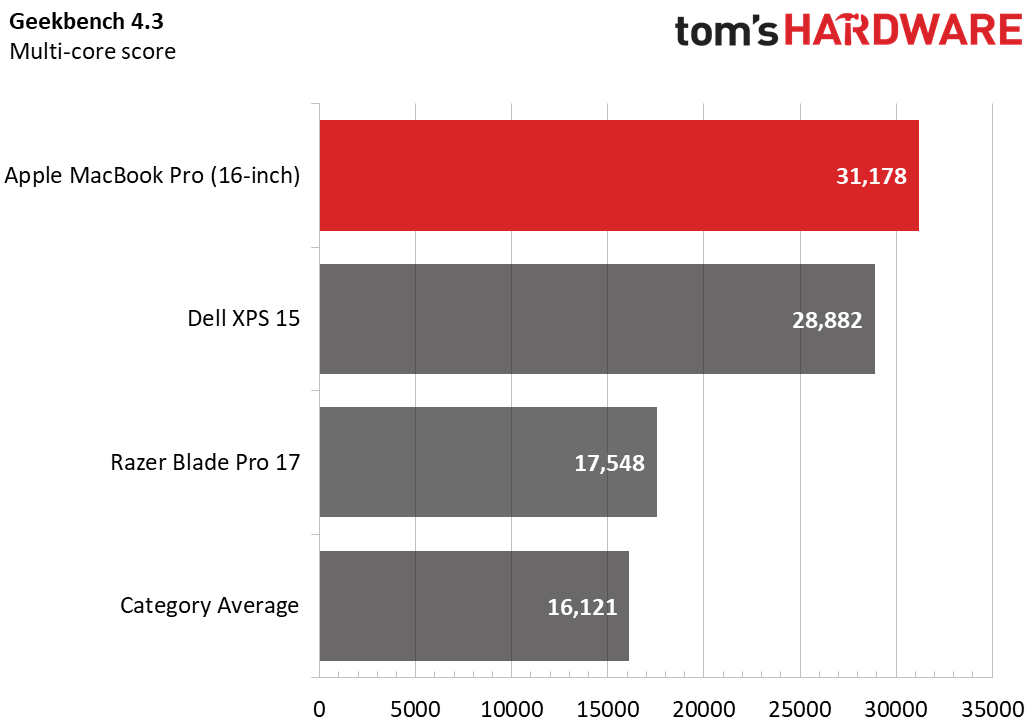
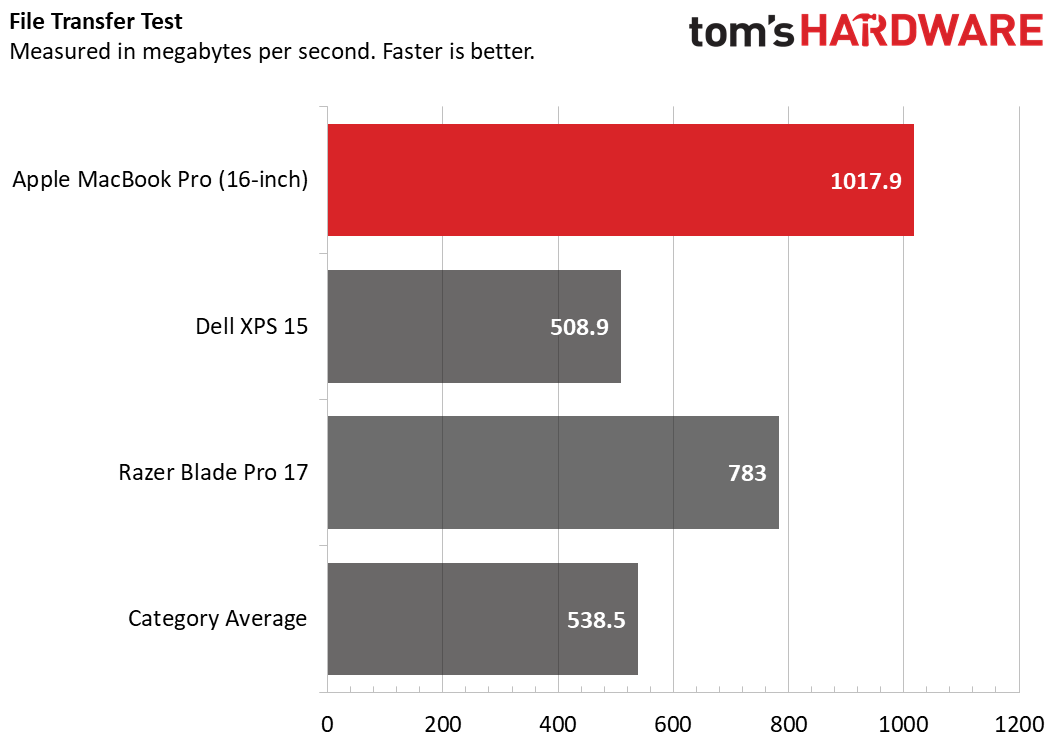


On Geekbench 4.3, the MacBook Pro earned a score of 31,178, outclassing the XPS 15 (Intel Core i9-9980HK, 28,882), the Blade Pro 17 (i7-9750H, 17,548) and the premium laptop average of 16,121.
Get Tom's Hardware's best news and in-depth reviews, straight to your inbox.
Apple’s APFS (Apple File System) makes duplicates of file metadata pointing at files, which makes copying seem instant. To test file transfer speeds, we ran our copy test through the Terminal. The machine transferred 4.97GB of files in 5 seconds, a rate of 1,017.9 MBps. That’s faster than average (538.5 MBps) and both of its competitors here.
The MacBook Pro took 8 minutes to transcode a video from 4K resolution to 1080p in our Handbrake test. That’s the exact same amount of as the XPS 15 took and faster than the premium laptop average (21:51) and the Blade Pro.
To stress test the MacBook Pro, we ran Cinebench R20 on a loop 20 times. During the test, the CPU ran at an average clock speed of 3.1 GHz and an average temperature of 84.9 degrees Celsius (184.8 degrees Fahrenheit). The Cinebench scores were largely stable. After a first-run score of 3,384, the rest of the runs normalized to between the low 3,200s and the high 3190s.
Gaming and Graphics Performance
The MacBook Pro has AMD’s Radeon Pro 5500M GPU with 8GB of memory.
As Apple has removed support for 32-bit games, the library on Steam is slimmer than ever.

We had trouble running some games, but one of them, Rise of the Tomb Raider, ran without issue. We ran the game’s benchmark at 1920 x 1200 (it doesn’t allow 1920 x 1080, due to the Mac’s 16:10 aspect ratio) on very high presets, just like on gaming laptops. It reached 24 frames per second (fps). The Razer Blade Pro 17, with a gaming-grade RTX 2070 Max-Q graphics card, ran the same benchmark at 62 fps. The average framerate among premium, non-gaming laptops is 25 fps.
At the medium preset with anti-aliasing turned down to FXAA, it ran at a much smoother 58.5 fps, so while it’s not the best gaming laptop, gaming isn’t out of the question on the MacBook Pro. You just have to hope the game you want to play actually runs on macOS.
Keyboard, Touchpad and Touch Bar
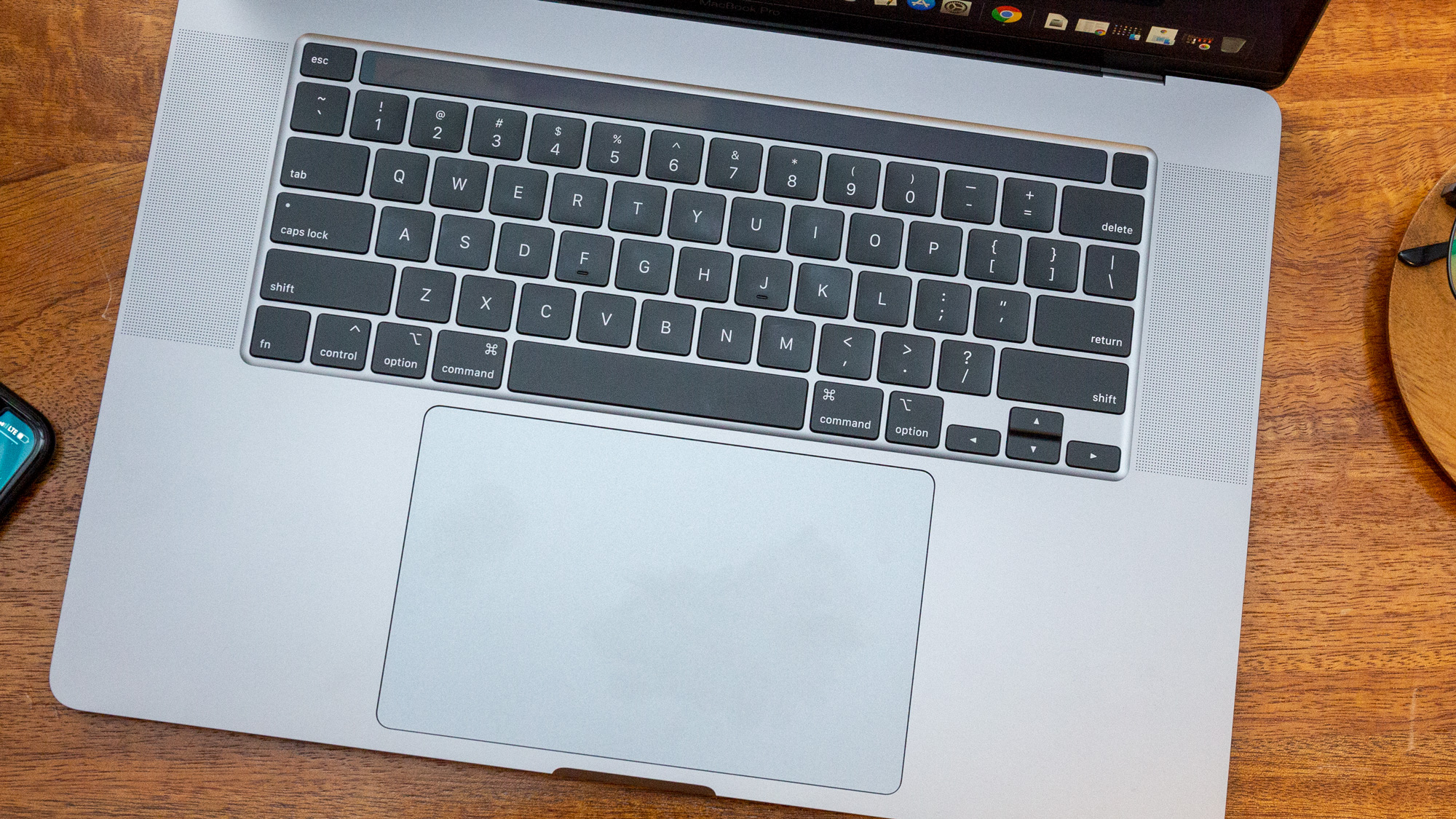
The elephant in the room: there’s no reviewing the 16-inch MacBook Pro without talking about the keyboard. This marks the first departure from the “butterfly” keyboard on the 13 and 15-inch MacBook Pro, as well as the MacBook and MacBook Air. Those were polarizing, due to low travel (I was fine with this. However, several of my colleagues and many MacBook Pro owners were vocal about disliking it). The keyboards were also subject to a repair program, stemming from debris or other issues causing keys to stick or cease working.
So I’m happy to say that Apple is back with the scissor switch on what it calls the Magic keyboard, and it’s excellent. On the 10fastfingers.com typing test, I hit 110 words per minute with a 2% error rate, both squarely in my usual range. There’s more travel, and there’s even a bit of a click. Welcome back, scissor switches. Here’s hoping we see you on other Mac laptops soon.
What’s missing, of course, are the function row keys. Apple has replaced these with the Touch Bar on every MacBook Pro model, though the 12-inch MacBook and the MacBook Air still have them. Sure, some apps allow you to scroll through video and audio, serve as media playback buttons, or allow auto-suggestions for phrases and emoji. But at the end of the day, it’s still not as useful as those dedicated keys, and I wish Apple would offer the options.
On the bright side, Apple has brought back the physical escape key, which means that the Touch Bar is a little shorter. On the other side, Touch ID has been built into the power button to sign in with your fingertip.
The Force Touch touchpad is massive at 3.9 x 6.3 inches. It’s way bigger than I’ll ever need it to be, but it’s still among the best I’ve used, with excellent palm rejection while I'm typing, a smooth glass touchpad and instant response to any of macOS’ many gestures. Sure, it doesn’t actually click, but I can’t tell the difference in my daily usage.
Display

Besides the keyboard, the biggest change is that Apple has introduced a bigger, higher-resolution display. It’s a 16-inch screen with a 3072 x 1920 display, stopping just short of 4K resolution. I wish Apple went slightly over 4K rather than under, as professionals may buy this machine to edit 4K videos.
We performed our tests with Apple's True Tone feature turned off. When I watched the 4K open source movie Tears of Steel, Celia’s blue and pink accents on her black jacket and pants appeared very accurate, though they didn’t necessarily pop the way it does on other screens, but it looked realistic.

Apple’s panel covers 114% of the sRGB color gamut. That’s slightly lower than the premium laptops (123%), which includes some OLED displays. The XPS 15, for example, measured 239% with an OLED panel, while the Blade Pro measured 109%.
The MacBook Pro measured an average of 429 nits of brightness, which beats the 360-nits premium laptop average. Only the Dell XPS 15, again, with its OLED display, was brighter (626 nits).
Audio
The six speakers on the 16-inch MacBook Pro are the best I’ve ever heard on a laptop. If my colleagues in our open office wouldn’t hate me, I’d use it as a boom box. When I listened to Halsey’s “Without Me,” the bass thumped in ways it doesn’t on other laptops. On “Wait For Me” from the Broadway soundtrack to Hadestown, it was the first time I heard Hermes’ deep voice quietly singing alongside Orpheus. And on Yellowcard’s “You and Me and One Spotlight,” there was a perfect balance between the clear vocals, snare drums and the violin.
It sounds great even when the speakers are turned up all the way. There’s no software to adjust the audio, but the MacBook Pro doesn’t need it. Other laptops should aspire to this sound.
Upgradeability
Pick the components you want when you buy the 16-inch MacBook Pro, because there is no upgrading the RAM or storage, which is common in many other laptops of this size. In this case, it’s all soldered to the motherboard. There are six P5 pentalobe screws on the bottom, so you can get the case open, but there’s not much going for it in the user upgradeability department.
Battery Life
If you’re performing simple productivity work, the MacBook Pro will last you all day. It endured for 10 hours and 55 seconds on our battery test, which continuously browses the web, streams video and runs OpenGL tests at 150 nits. To keep things consistent, we also turned True Tone off for the display.

The Dell XPS 15 endured for 8:07, though the OLED screen surely didn’t help, and the Razer Blade Pro 17, with a gaming-grade graphics card, lasted just 4:31. The average premium laptop average is 8:33.
Heat

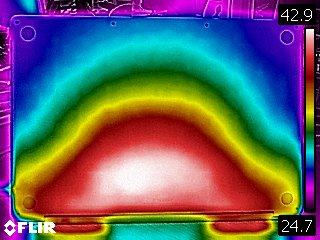
During our Cinebench R20 stress test, we also measured the 16-inch MacBook Pro’s skin temperature.
Between the G and H keys at the center of the keyboard, it measured 42 degrees Celsius (107.6 degrees Fahrenheit), and the Force Touch trackpad was cooler at 30.3 degrees Celsius (86.5 degrees Fahrenheit).
The hottest point on the bottom of the Mac measured 42.9 degrees Celsius (109.2 degrees Fahrenheit).
Webcam

The MacBook Pro has a 720p “FaceTime HD” webcam. At this price, I wish Apple would spring for a 1080p camera, but it’s still a solid lens. Colors were precise, and it reproduced the red and navy in my plaid shirt, as well as the many different colors in my beard. While the hairs on my head appeared sharp, some other parts of the image (again, my beard) looked slightly fuzzier.
Software and Warranty
Unlike devices running Windows 10, the MacBook Pro comes free of bloat. Apple ships macOS with free productivity software, including Pages, Numbers and Keynote. There's also a suite as of apps, like Home, News and Photos, that sync with iPhone and iOS or iPad and iPadOS.
Apple has eliminated support for 32-bit apps from macOS Catalina. Many developers have caught up (particularly those that deliver software through the App Store), but make sure that the software you use is supported. If you need to return to a clean version of macOS, here's how to reset a MacBook.
Apple sells the 16-inch MacBook Pro with a one-year warranty and 90 days of complimentary tech support. You can buy more support and hardware coverage with AppleCare+ for $379.
Configurations
We tested a $3,899 configuration of the 16-inch MacBook Pro with an eight-core, 16-thread Intel Core i9-9980HK, 32GB of RAM, 2TB of storage and an AMD Radeon Pro 5500M GPU with 8GB of GDDR6 memory. That’s a souped-up version of the $2,799.00 model with an Intel Core i9 CPU running at 2.4 GHz, 16GB of RAM, 1TB of storage and a Radeon Pro 5500M with 4GB of GDDR6 memory.
The base model is $2,399.00 with a 2.6 GHz, six-core, 12-thread 9th-Gen Intel Core i7 CPU, AMD Radeon Pro 5300M with 4GB of memory, 16GB of RAM and 512GB of storage.
The CPU, RAM, storage and GPU can be configured at the time of purchase.
Bottom Line
This is the MacBook Pro that professionals have needed. The larger display will likely entice video editors, and the sound is great, whether you’re a creator or just casually listening to music.

It offers strong performance and lasts a long time on a charge. And, of course, the keyboard is better. It’s hard to celebrate too much (after all, it’s mostly what’s old being new again), but I can assure you that everyone who wants a MacBook is waiting for this keyboard to hit the whole lineup.
If you use 32-bit apps and want low-level gaming, something like the Dell XPS 15 might be more your speed. If you don’t need a super-accurate display, you get options for OLED, as well as a touchscreen if desired. It’s also cheaper. I priced out a version with the exact same CPU, a 4K non-touch display, 32GB of RAM, a 2TB SSD and an Nvidia GeForce GTX 1650 with 4GB GDDR5 memory. It was $2,849.99, more than $1,000 dollars less than our review subject (though, you may be getting a lesser GPU).
But if you want a Mac and only a Mac, the new MacBook Pro is the one you’ve been waiting years for.
MORE: Best Gaming Laptops
MORE: Gaming Laptop Previews
MORE: All Laptop Content

Andrew E. Freedman is a senior editor at Tom's Hardware focusing on laptops, desktops and gaming. He also keeps up with the latest news. A lover of all things gaming and tech, his previous work has shown up in Tom's Guide, Laptop Mag, Kotaku, PCMag and Complex, among others. Follow him on Threads @FreedmanAE and BlueSky @andrewfreedman.net. You can send him tips on Signal: andrewfreedman.01